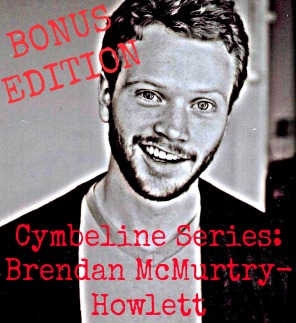
We are so thankful to directors Anita Rochon, Dawn McCaugherty, and Antoni Cimolino, who have shared their take on Cymbeline with us over the past month in our Cymbeline Series. Now that Ruff’s production is up and running, Brendan McMurtry-Howlett, our Artistic Director and director of Cymbeline’s Reign, tackles the same three questions we put to these thoughtful and generous theatre practitioners.
1. For a title character, King Cymbeline has very little time on stage and no time alone with the audience. How did you ensure that audiences would connect with him? Do you think the play would be better served by a different title?
Well, we did change the title of the play. And I guess this is as good a place as any to discuss our adaptation – what we did to the original script and why.
Shakespeare’s original script is an epic and intricately woven story filled with beauty, compassion, and morbid humour. Every seemingly insignificant detail laced into this story ends up playing a key role in the play’s famous final scene where everything is resolved in what can only be described as a miracle. The original, with all of the myriad plot details, would run at about three hours which is just not possible for us in our park setting, so cuts and edits are required.
Now, as far as I’m concerned, the moment you cut one word from Shakespeare, you are creating an adaptation – you are making decisions about what to focus on for your own individual production for your own specific audience. In an attempt to “do justice” to the play, often cuts are made evenly across the board to keep every element of the original in the edited script while reducing the content to roughly half of the original. What I’ve often experienced in these cases is that although a gesture of all of the play’s original elements are included in the edited version, what remains resembles more an excavated medical cadaver than a living and breathing play.
In our approach, we opted to fully embrace the spirit of adaptation and, as such, changed the name of the play to let our audiences know that what they would be seeing was not the original Shakespeare script, but rather our artists’ creation specifically for our audience and setting. I’m proud to say that it’s a world premiere of an original Shakespeare play.
Another aspect we focused on in our decision to adapt were elements in the original that were key social issues of the day when Shakespeare wrote the play in 1610-1611 – mainly the notion of needing a male heir of royal blood in order for security and harmony to be reestablished in the kingdom. In the original script this is done through the reemergence of Imogen’s missing brothers, which allows Imogen to marry an orphan boy without her family losing the throne. I could go into all the political reasons as to why this element was crucial to Shakespeare’s era when he wrote the play, but the basic fact is, the notion of maintaining a class system led by men, is contrary to the kind of society we all wish to live in today.
By no means is this the only thing we’re left with at the end of this play. It could be argued that in a modern production, this element may not even be noticed by audiences and, therefore, could be argued to be irrelevant. But I firmly believe that as artists and storytellers, we need to take full responsibility for what we put out into the world. I didn’t feel it would responsible considering my feminist upbringing to put that kind of story into the world – my mother would disown me.
Now, just to be clear we had no interest in creating a polemic rant against male-centric hierarchy (although a good rant now and again doesn’t hurt). We wanted to focus on the miracle of compassion and acceptance which I believe is truly at the heart of Shakespeare’s original, so we opted to simply remove the male-heir-restoring-harmony element.
In our extensive research on this play (which surprisingly uncovered a long history of derision and dismissal of this play from over a century of critics) we discovered many fascinating adaptations along the way. George Bernard Shaw felt so affronted by what he deemed the ridiculous nature of Shakespeare’s final scene in this play that he decided to re-write the whole 5th act – if you’re curious, click HERE to read it.
The most exciting thing we found was an adaptation written in 1779 by British poet Henry Brooke. He rewrote the entire play, using Shakespeare’s characters and basic premise but taking it in quite a different direction (spoiler alert: there’s an insane human sacrifice scene at the end). The most interesting thing that Brooke did was completely remove the plot line of the missing brothers in the cave and instead focused in on the journey of Posthumus and Imogen. This was one possible approach we had already been discussing and took the uncovering of Brooke’s script as a sign to continue. Brooke also fleshed out the story of the Queen’s plot to usurp the throne, which we found intriguing. Plus, who doesn’t want an excuse to have that amazing character on stage more!
Inspired by Brooke’s play, we took pieces of his text and pieces of text from what must be more than a dozen of Shakespeare’s other plays to remove the brothers plot line and fill in the many holes that their removal created. Instead, we sharpened the focus on Imogen’s journey and renamed the play Cymbeline’s Reign to highlight the idea that although King Cymbeline isn’t the main character in our play, everything stems from the decisions he makes. He is both the first and last obstacle put between lovers Imogen and Posthumus. (If anyone is curious to read Henry Brooke’s script, send us an email and we’ll point you in the right direction!)
2. Most deus ex machina (god from the machine) moments are vital to the story. Jupiter’s descent on the back of an eagle in Cymbeline is often cut and feels less integrated than many similar interventions by the Gods in other plays. What was your take on this moment and how important a role did the unseen whims of the deities play?
Researching this play, reading and re-reading it along with all of Shakespeare’s other “Romances” (Pericles, The Winter’s Tale, The Tempest, Two Noble Kinsmen), it’s clear these late-career plays took a sharp turn away from the great tragedies for which Shakespeare is known. The main difference that I noted was that the driving action of the play is propelled by individual characters’ thoughts and actions and how they influence the world around them, for better or for worse. We follow one, or a few main characters’ psychological journeys as they cope with the decisions they make and the consequences that arise from those decisions. But in the “Romances”, Shakespeare seemed far more interested in how a character’s journey was shaped by external elements outside of their control that pulled or pushed them through the action of the play. The main characters are more like swallows in a strong headwind, rather than the great engines in his earlier plays. Reading Dan Falk’s recent blog post connected a lot of dots for me based on what I was seeing in these plays – at the time of Shakespeare’s shift into the Romances, there was a huge change happening in science and society where, because of Galileo’s discovery of Jupiter’s four moons, humans started to really understand the notion that planet Earth, and therefore all humans, were not at the centre of the universe, but are just a miniscule part of something much larger.
In Cymbeline, as well as in Pericles and Two Noble Kinsmen, Shakespeare uses the metaphor of the Roman and Greek Gods, to represent those external elements. In Shakespeare’s original script, the final moment of the play is a deciphering of a tablet left for Posthumus by the god Jupiter, which essentially tells all of the mortals that all of the fantastical and unbelievable things that happened to them over the course of the play were in fact all coordinated by Jupiter himself (and his pet eagle).
Jupiter’s decent on the back of an eagle before Posthumus is the physical manifestation of the idea that Posthumus doesn’t have all the answers. Although he attempts to control his destiny in his quest for death, this moment reminds him that he doesn’t necessarily have control over his own life, which in this case, turns out to be a good thing. In our adaptation, we have not cut Jupiter, but have actually heightened the moment of intervention that exists in Shakespeare’s original and made it more direct.
3. Cymbeline isn’t produced very often, especially in Canada; is it just the ebb and flow of fashion, or are people are afraid to do it? And if so, why?
It’s a hell of a thing to produce – fight sequences, figuring out what to do with Jupiter, worrying that the audience might get lost in the labyrinthine plot twists. But I think more than the logistical nightmare it poses, this play, more than his others, doesn’t have much life on the page. It reads more like an entire season’s worth of soap opera plots condensed into one play. I found it incredibly hard at first to figure out what was actually at the heart of each scene and what characters wanted from each other moment to moment.
I don’t think that it’s an accident that many generations of critics haven’t had many positive things to say about this play – it’s not a piece that holds up to academic and literary analysis and lacks the poetic language of Shakespeare’s better-known plays. It only truly comes alive at full-speed. The scenes and each character’s drive starts to make a lot more sense when you remove any time to think; all of the characters act and react from pure impulse. None of the characters really think anything through; they simply don’t have time with all of the elements of their world applying pressure on them.
In rehearsals I told all of the actors that this play wouldn’t make much sense until we got it up to speed. I kept encouraging them to speak and do faster than they could think. The recurring questions of, “why does Imogen do this bizarre thing in this moment? Why does Posthumus make this insane decision here?” started getting answered when we removed the characters’ time for deep analysis of their situation. When the actors started to act from the gut, they found that the choices their characters made responded far more to their emotional state than to any kind of deep psychology. I found myself learning far more about the scenes and the play watching the actors in action than I did from reading the play two dozen times on my own.
When reading it the first time, one can get a very simplistic view of the play and these characters, reducing them to archetypes without much depth, but when you put them into action, they come alive. You’ve got to have a lot of courage and trust in Shakespeare to believe that what you read on the page is just the very beginning of this “beautiful mountain” as Antoni Cimolino so aptly put it.


Excellent interview. Although I’ve already seen the play and plan to see it again, this helped my understanding a great deal. Thank you SitR. Thank you Brendan.
Very interesting to read your take on the play after having seen it last week. I agree that the play does come alive and make sense as you have staged it.